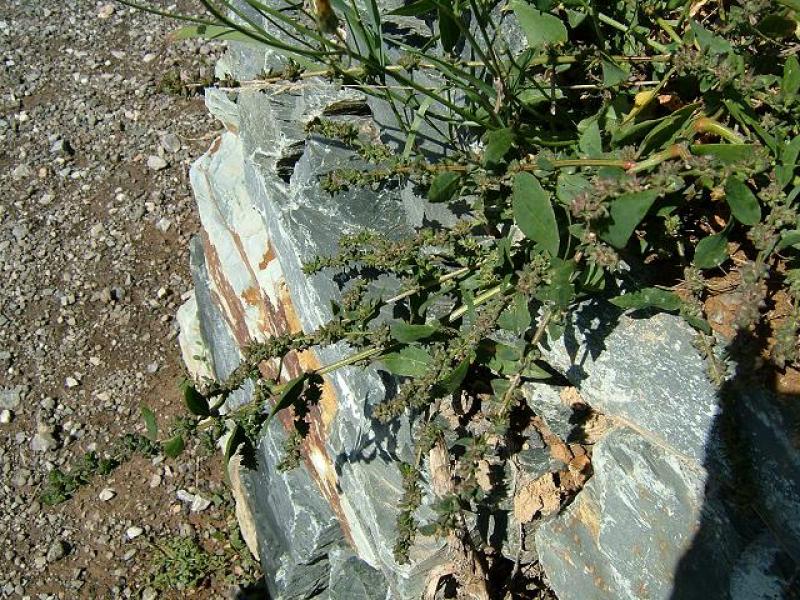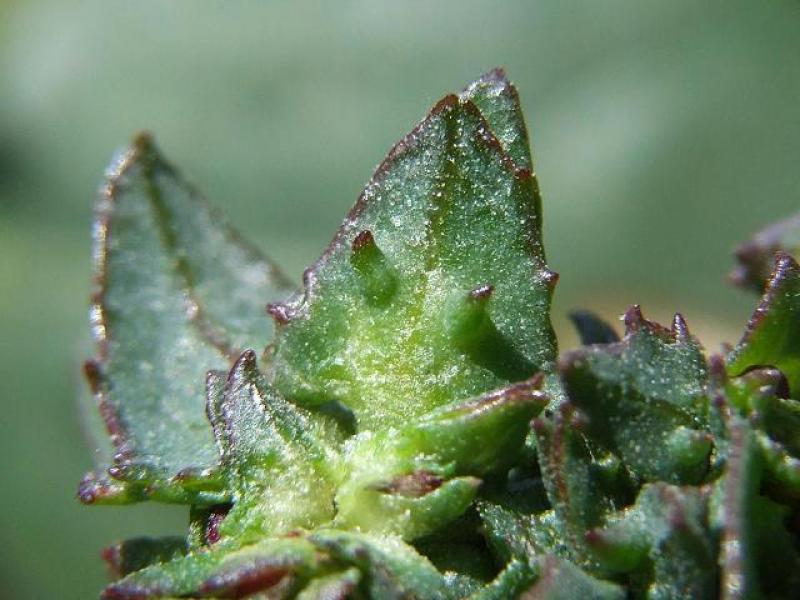Seaside Orach
Atriplex glabriuscula Edmondston
- Class
- Dicotyledoneae (Dicots)
- Family
- Amaranthaceae (Amaranth Family)
- State Protection
- Endangered
Listed as Endangered by New York State: in imminent danger of extirpation in New York. For animals, taking, importation, transportation, or possession is prohibited, except under license or permit. For plants, removal or damage without the consent of the landowner is prohibited.
- Federal Protection
- Not Listed
- State Conservation Status Rank
- S1
Critically Imperiled in New York - Especially vulnerable to disappearing from New York due to extreme rarity or other factors; typically 5 or fewer populations or locations in New York, very few individuals, very restricted range, very few remaining acres (or miles of stream), and/or very steep declines.
- Global Conservation Status Rank
- G5
Secure globally - Common in the world; widespread and abundant (but may be rare in some parts of its range).
Summary
Did you know?
Before 1990 this species was not known from New York State but in September of that year two populations were discovered within one day of each other at two different places by two different botanists. One population was discovered on Fishers Island in Long Island Sound and one near Orient Point on the North Fork of Long Island.
State Ranking Justification
There are three existing populations in New York, but this species has only been known in the state since 1990. One population is small with fewer than 50 plants and population numbers are unknown but probably fairly small for the other two populations since the marshes they are in are small.
Short-term Trends
All three existing populations have not been resurveyed so short-term trends are unknown.
Long-term Trends
This species was only discovered in New York in 1990 so long-term trends are unknown.
Conservation and Management
Threats
One site has development nearby and may be affected by the increase in human disturbance. Threats are unknown in the remaining populations.
Conservation Strategies and Management Practices
Control Phragmites invasions in the salt marshes where it exists and prevent new incursions. Natural buffers should be established around the salt marshes to decrease pollution runoff and other direct human disturbances.
Research Needs
Research is needed to understand what is limiting both population numbers and size on Long Island.
Habitat
Habitat
In New York Seaside Orach has only been collected from the upper edges of rocky beaches (New York Natural Heritage Program 2010). Saline or brackish marshes and saline coastal strands (FNA 2003). Sea beaches (Gleason and Cronquist 1991).
Associated Ecological Communities
- Marine intertidal gravel/sand beach
(guide)
A community washed by rough, high-energy waves, with sand or gravel substrates that are well-drained at low tide. These areas are subject to high fluctuations in salinity and moisture. A relatively low diversity community, it is perhaps best characterized by the benthic invertebrate fauna including polychaetes, and amphipods.
Associated Species
- Artemisia campestris
- Atriplex patula (spear orach)
- Chenopodium
- Erechtites hieraciifolia
- Fallopia scandens (climbing false buckwheat)
- Lathyrus japonicus
- Oenothera
- Xanthium strumarium
Range
New York State Distribution
This herb is only known from Fishers Island in Suffolk County where it was discovered in 1992.
Global Distribution
This saltmarsh plant is most common in northeastern Canada but ranges south to New York and west to Manitoba and Nebraska. It is considered introduced in Illinois and Kentucky.
Identification Comments
General Description
Seaside Orach is an herbaceous annual plant with often prostrate stems up to 1 meter long. The leaves are opposite or nearly so, triangular or arrow-shaped, sometimes with two opposite lobes near the base, and a few large teeth. The infloresence is terminal, with leaves or bracts throughout. The female flowers lack petals or sepals, and are enclosed by two triangular leafy bracteoles, these 5 to 13 millimeters long and joined together from the base to near the middle. The seeds are dimorphic: either brown and 2.5 to 4 mm wide, or less commonly, black and 1.5 to 2.5 mm wide (Gleason and Cronquist 1991).
Best Life Stage for Proper Identification
Seaside Orach is most easily identified when in fruit.
Similar Species
Unlike Atriplex glabriuscula, Atriplex hastata does not have leaves or bracts throughout the inflorescence. Atriplex laciniata has hard bracteoles enclosing the seeds and similarly shaped but scurfy leaves. In contrast, Atriplex glabriuscula has spongy herbaceous bracteoles and smooth leaves. (Gleason and Cronquist 1991).
Save file
Best Time to See
Seaside Orach is an annual species, flowering in late summer and persisting into November.
- Flowering
- Fruiting
The time of year you would expect to find Seaside Orach flowering and fruiting in New York.
Seaside Orach Images
Taxonomy
Seaside Orach
Atriplex glabriuscula Edmondston
- Kingdom Plantae
- Phylum Anthophyta
- Class Dicotyledoneae
(Dicots)
- Order Caryophyllales
- Family Amaranthaceae (Amaranth Family)
- Order Caryophyllales
- Class Dicotyledoneae
(Dicots)
- Phylum Anthophyta
Additional Common Names
- Glabrous Orach
- Scotland Orache
Synonyms
- Atriplex patula ssp. glabriuscula (Edmondston) H.M. Hall & Clem.
Additional Resources
Best Identification Reference
Flora of North America Editorial Committee. 2003. Flora of North America North of Mexico, Volume 4, Magnoliophyta: Caryophyllidae, Part 1. Oxford University Press, New York.
Other References
Fernald, M. L. 1950. Gray's manual of botany. 8th edition. Corrected printing (1970). D. Van Nostrand Company, New York. 1632 pp.
Gleason, Henry A. and A. Cronquist. 1991. Manual of Vascular Plants of Northeastern United States and Adjacent Canada. The New York Botanical Garden, Bronx, New York. 910 pp.
Holmgren, Noel. 1998. The Illustrated Companion to Gleason and Cronquist's Manual. Illustrations of the Vascular Plants of Northeastern United States and Adjacent Canada. The New York Botanical Garden, Bronx, New York.
Mitchell, Richard S. 1986. A checklist of New York State plants. Bulletin No. 458. New York State Museum. 272 pp.
Mitchell, Richard S. and Gordon C. Tucker. 1997. Revised Checklist of New York State Plants. Contributions to a Flora of New York State. Checklist IV. Bulletin No. 490. New York State Museum. Albany, NY. 400 pp.
New York Natural Heritage Program. 2024. New York Natural Heritage Program Databases. Albany, NY.
Weldy, T. and D. Werier. 2010. New York flora atlas. [S.M. Landry, K.N. Campbell, and L.D. Mabe (original application development), Florida Center for Community Design and Research http://www.fccdr.usf.edu/. University of South Florida http://www.usf.edu/]. New York Flora Association http://newyork.plantatlas.usf.edu/, Albany, New York
Links
About This Guide
This guide was authored by: Stephen M. Young
Information for this guide was last updated on: September 20, 2012
Please cite this page as:
New York Natural Heritage Program. 2024.
Online Conservation Guide for
Atriplex glabriuscula.
Available from: https://guides.nynhp.org/seaside-orach/.
Accessed July 26, 2024.

